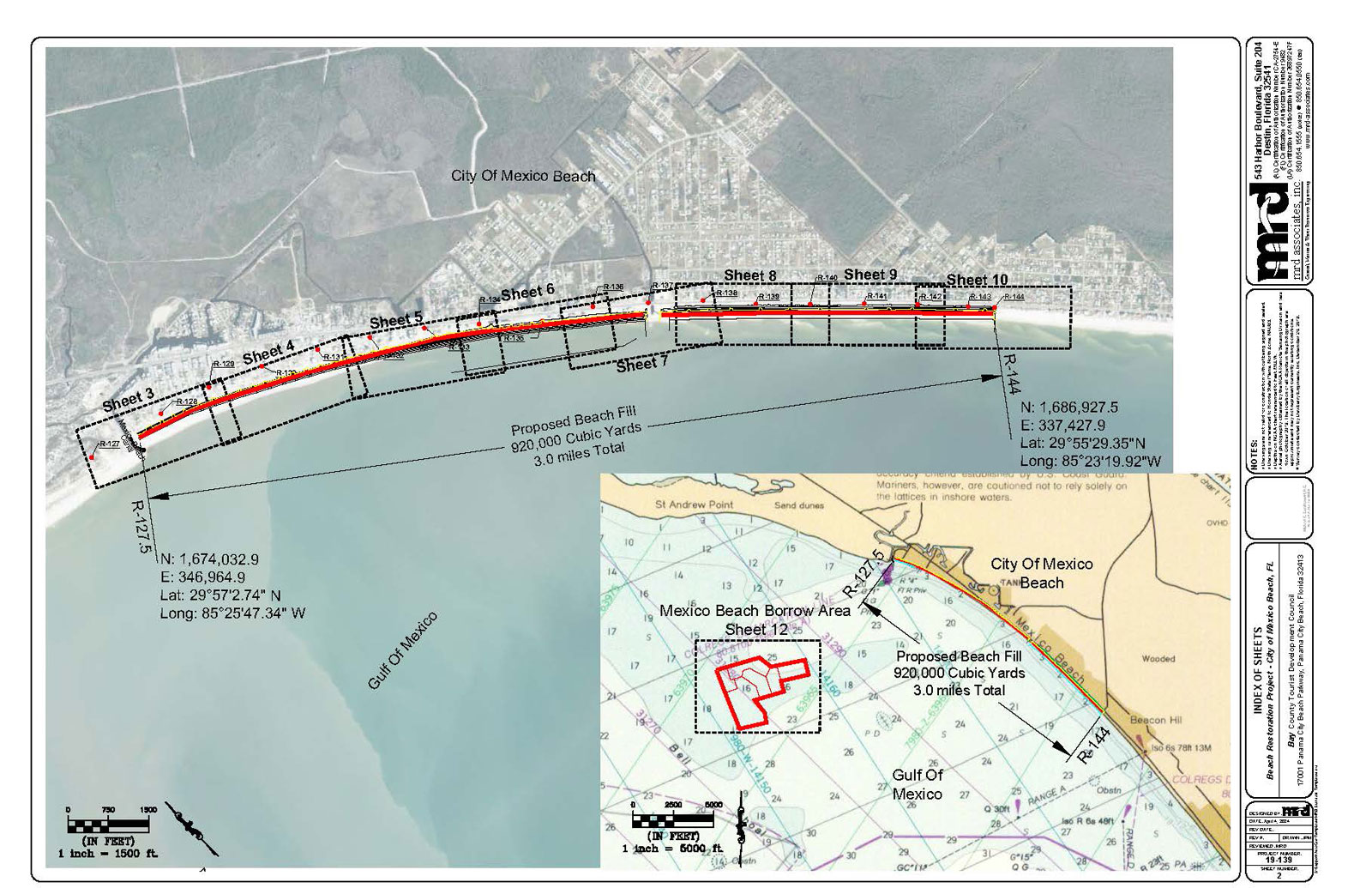Beach Restoration
The first full-scale beach nourishment of the Mexico Beach shoreline is currently under construction, with an anticipated completion by May 1st, 2025. This is a very important storm protection project for Mexico Beach that has taken years of hard work and planning to make happen! In fact, the Mexico Beach Community Development Council began work on this project prior to the devastation caused by Hurricane Michael. The following questions and answers provide many of the details about the project and will be continually updated.
Q: Where is this project taking place?
The beach nourishment project will cover the entire approximate three-mile City of Mexico Beach shoreline from the Mexico Beach Canal at the western end to the Gulf County line at the eastern end. The project will consist of both dry sandy beach berm and dune construction.
Q: Why is this project important?
This project is first and foremost a shore protection project intended to provide critical storm protection for public and private infrastructure, structures, and property upland of the beach. While storm protection is the priority, the project will also provide additional recreational beach width for the benefit of residents and visitors as well as habitat for several species such as shorebirds and sea turtles.
Q: How much sand is being placed as part of this project and how wide will the beach be?
Nearly one million cubic yards of sand will be placed with this first full-scale beach restoration project for the Mexico Beach shoreline. The project consists of a dune-only component on the west end of the beach and then transitions to a dune and beach berm around 34th Street all the way to the Bay/Gulf County line. The beach berm will be extended approximately 175 feet from the seaward toe of the proposed dune.
Q: How long will this project take to construct?
The project is expected to take approximately three months; however, construction may move faster or slower. There may also be circumstances that cause lengthy delays due to construction shutdown, like weather conditions or major repairs to equipment, so please check the construction schedule for updates.
Q: What is the project construction schedule?
(02/05/25) The project has commenced between R-134 & R-135 marker (El Governor Resort) and will head West towards the canal. Please monitor the Construction Schedule for further details. A new schedule will be posted and updated at least once every seven days. Construction plans are below.
Construction Plans- Mexico Beach Restoration Project
Q: Who is managing this project?
The Bay County Tourist Development Council, the Mexico Beach Community Development Council and Bay County will be managing the construction of the project in coordination with the City of Mexico Beach.
Q: Who is the dredging contractor?
Weeks Marine is the dredging contractor.
Q: What is the cost of this project and who is paying for it?
The full contract cost with Weeks Marine is $27,180,950. However, it could possibly be slightly less given options may become unnecessary and not needed. The project is initially being paid for by the Bay County Tourist Development Council from the beach renourishment fund. After working tirelessly for years, the Mexico Beach Community Development Council secured several grants: two separate grants from the State of Florida Department of Economic Opportunity (DEO) and one from the Florida Department of Environmental Protection (FDEP). The combined totals from all grant entities cover the entire cost of the contract, which will be reimbursed to the renourishment fund. These grants are being issued through the Bay County TDC and Bay County BOCC. The Florida DEO in Community Block Grant Disaster Recovery (CDBG-DR) Rebuild Florida General Infrastructure Repair Program funding award a $4,270,000 grant and the two FDEP grants total $22,910,950 in federal American Rescue Plan Act (ARPA) funding.
Q: Where is the sand coming from that is being placed on the beach?
The sand for large-scale beach nourishment projects comes from our permitted, offshore “borrow area.” The Mexico Beach borrow area is located approximately three miles offshore of Mexico Beach.
Q: How does the sand get to the beach?
The sand is dredged from the offshore borrow areas via a cutter dredge. The dredge attaches to a submerged pipeline, which lays on the seabed and comes up onto the beach, which then runs parallel to the shoreline. The sand is discharged as a water and sand slurry mixture through the pipeline. The sand stays on the beach, and the water runs back into the Gulf. Bulldozers reshape the newly discharged sand to meet the designed construction template.
Q: Why does the sand coming out of the pipe look darker than the sand on the beach?
The sand coming out of the pipe is a water and sand slurry mixture, and it often contains darker, fine material that washes out as the sand is reshaped on the beach by the bulldozers and dries out over time. This is not contamination. There is a detailed Quality Assurance/Quality Control plan in place that will immediately address any sand quality issues that may arise.
Q: How fast does the project move down the beach? How long will it be in front of my property?
Construction should progress at a rate of 250 feet to 1,000 feet per day. Barring any temporary work stoppages, this means the active construction area may only be in front of your property for a couple days, but that could be longer. Please be patient. Everyone, including the contractor, engineers, and the Bay County TDC, Mexico Beach CDC, and Bay County wants the project to continue moving down the beach and closer to completion as quickly and safely as possible.
Q: How do I access the beach when construction is occurring in front of my property? How do I get over the dredge pipe?
The active work/construction area is limited to an approximate 1,000 to 2,500-foot sections of beach. Walk laterally along the beach until you get around the active work area, locate a sand bridge that goes over the dredge pipe, and you will be able to access the Gulf. The contractor will build sand bridges over the dredge pipe, which is laid laterally along the shoreline, so that pedestrians may have access to the Gulf.
Q: If I have a walkover, will sand placement bury my dune walkover structure?
If your dune walkover structure does not have railings, it will be buried by the sand placement. If the structure has railings, sand will be piled on either side but not placed directly on the structure. Sand will only be placed within the designated fill template, which extends from the crest of the current dune seaward. Structures landward of the existing dune will not be disturbed.
Q: Can I remove my structure before the project begins?
Yes, homeowners may choose to remove their structures prior to the start of sand placement. Removal will be at the homeowner’s discretion and expense.
Q: Can I replace my dune walkover after the project is completed?
Yes, you may replace your dune walkover after the project is completed, at the homeowner’s expense. However, any replacement or construction of dune walkovers requires obtaining a Coastal Construction Control Line (CCCL) Field Permit. Please contact the City of Mexico Beach Building Department for more information about the permitting process [click here for the building dept.].
Q: What are the work hours for construction and is it noisy?
Unless the work temporarily ceases for repair or weather, work will continue 24 hours a day. Bulldozers, front-end loaders, and other large pieces of equipment will be used in the construction of the beach project and can be noisy. These are extremely expensive projects, and it is not feasible to halt work overnight or on weekends.
Q: Can I still rent out my home/condo during construction?
Like many other beach communities such as Panama City Beach, during construction of a beach project, renters and owners still enjoy the beach and typical vacation activities during construction. Some safety restrictions around the “active construction” site will limit access to the public but as noted above, the beach will remain open, and the “active construction” site will move down the beach. However, we cannot predict where and when the crews will be working and if it will impact your property during a given week. As noted above, the construction schedule will be updated at least every seven days once construction commences.
Q: What is beach tilling?
The tractor and plow-like attachment that people may see operating on the beach at the completion of the dredging and sand placement is the permit-required tilling. This activity is required once per year by permit immediately following construction and for three years following the project completion. The tilling loosens the sand in advance of sea turtle nesting season. Notably, with a little bit of time and weather events like heavy rain, the beach will return to a more “normal” state.
Q: What about sea turtle nesting?
The project is intended to be constructed outside of sea turtle nesting and hatching season.
Q: What is an Erosion Control Line?
An Erosion Control Line (ECL) is a boundary line fixed by the state on a nourished beach dividing private (landward) and public (seaward) property. See Florida Statutes, Section 161.191. It is set at the mean high water line and established before the first nourishment. See Florida Statutes, Section 161.161(5). In the state of Florida, the establishment and approval of an erosion control line is required before the initial construction of a nourishment project. For additional information, see links below.
Erosion Control Line and Mean High Water Fact Sheet
Erosion Control Line Map- Mexico Beach
Notice of Public Workshop and Hearing
Mexico Beach ECL Workshop Public Hearing
Erosion Control Line Public Workshop & Public Hearing Meeting Video recorded June 20, 2024

Project Areas and Construction Schedule*:
The construction area will be the entire length of shoreline in Mexico Beach (eastward of the Mexico Beach canal towards the county line/Highway 386 & Highway 98). Equipment and pipeline will begin arriving early to mid-January 2025, at the 37th Street parking lot and access. The dredge will arrive at the end of January for an approximate February 1st start date. Dredging is expected to take 1.5-2 months, with dune vegetation planting and complete demobilization of the project by April 15, 2025.
Beach Restoration Project Schedule- April 3, 2025
Weekly Forecast
January 28, 2025 (overhead plot)
*Please note that schedule is subject to change and will be weather and equipment dependent. Check back frequently for updates. A weekly update will be provided in written and map form once the project commences in February, 2025.
Mexico Beach Community Development Council
Welcome Center
102 Canal Parkway
Mexico Beach, FL 32456
Contact: 850-648-8196


